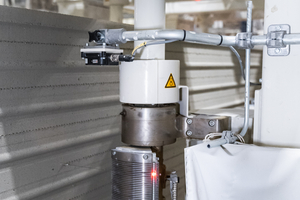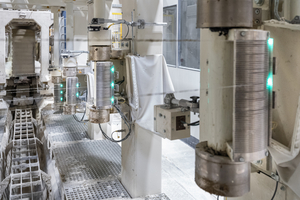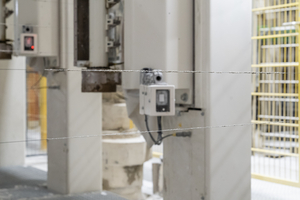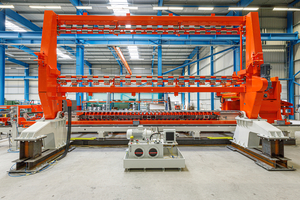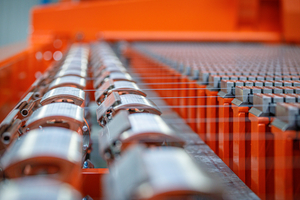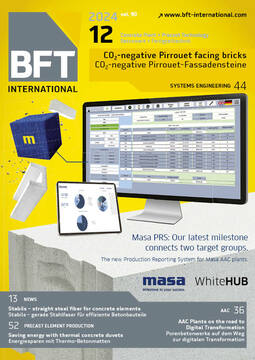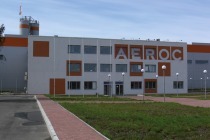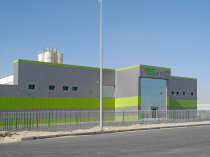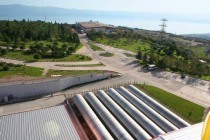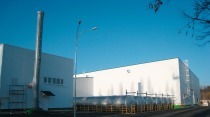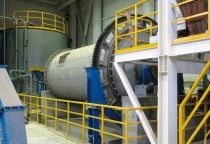Precise, flexible and reliable: AAC plants from Hess AAC Systems
Hess AAC Systems B.V. develops and builds highly specialised plants for manufacturing AAC elements with capacities of over 2.000 m³/day, based on decades of experience. Developed out of Durox and Hebel, the plant technology offers outstanding reliability and advantages for new and existing plants.
For more than 40 years, the company, based in the Netherlands, has been involved in the development and construction of plants for the production of autoclaved aerated concrete (AAC) elements. The foundation stone was laid in the 1980s, when the first AAC production machine was delivered under the name of Stork Bouwtechniek. The Durox and Hebel plants, among others, that were manufactured at that time are still in operation. When the Hess Group took over the business unit of Stork Bouwtechniek in 2006, Hess AAC Systems B.V. was established, and it continues to benefit from its specialised expertise in the design, development and construction of plants for the production of autoclaved aerated concrete. Hess AAC Systems focuses on the competitiveness and innovation of its products, which are known and valued for their quality, reliability and first-class service.
Increasing demands on the product also require constant expansion and improvement of machine precision. Driven by this quest for perfection, Hess AAC Systems has developed its plants to such an extent that product precisions of +/- 0.2 mm are standard, but not the limit.
For a green building rating, scrap rates of under 0.5 % are a must to increase the profitability of a AAC Factory to a maximum. Here again, Hess AAC Systems sets standards.
Comprehensive know-how
Hess AAC Systems has a highly qualified team of engineers. The company relies on its many years of experience, stretching back to the Stork offers for various cutting systems and handling equipment for a wide range of different production technologies. Hess AAC Systems‘ expertise is therefore comprehensive: both for the modification of plants, ranging from cake plants such as Durox, Siporex and Hebel to tilting cake plants such as Ytong, and for new plants, where since the 2000s the advantages of the previously existing technologies have been combined with the Keen-Crete concept of Hess AAC, based on a tilt and back-tilt technology with green separation for waste-free production. This experience has proven to be a reliable basis for solutions that can be integrated into existing plant technology.
The philosophy of Hess AAC Systems is to provide customers with state-of-the-art production plants that meet the specific capacity and product range requirements of their markets, such as:
Blocks,
Lintels,
Various kind of AAC Panels,
Storey-high partition walls,
Reinforced mounting components and panels,
Mineral thermal insulation panels with a minimum thickness of less than 50 mm.
Case study Brimax: the perfect design for the Indian market
The Keen-Crete concepts from Hess AAC Systems guarantee a high degree of flexibility in plant design, based on expertise and experience in the field of cutting systems for tilting and flat cake technology. The use of proven standard machines and components ensures a very high level of reliability.
The fact that Hess AAC Systems not only makes promises but also has the expertise to keep them is impressively demonstrated by the Indian showcase project Brimax. A turnkey aerated concrete plant is being built near Vadodara that will produce high-quality blocks with the utmost precision, with an initial capacity of 680 m³/day and the option to expand to over 900 m³/day. In close cooperation with the local Topwerk India team, Hess AAC Systems is providing a customised solution for a cost-efficient production process, thereby making an important contribution to Brimax‘s success in the Indian market.
Case study H+H: increased efficiency through high-precision cutting system
H+H has equipped one of its European production plants with a new high-precision cutting system from Hess AAC Systems. This development represents a significant advance in production quality and operational efficiency and demonstrates the trend in the industry towards more advanced, automated solutions.
In the first cutting station, the top crust and the bottom of the cake are removed. Tongue and groove profiling is carried out on the station downstream of the pre-cutting. The profile blades are changed by a 7-axis robotic system. This robot also picks up the knives in an automatic tool changing cycle to clean the knives or to change the knife blades.
After profiling, the cake enters into the new high-frequency, high-accuracy cutting system. In this process, the cake is cut to wall thickness using cutting wires that are adjustable in frequency and amplitude. With an achievable accuracy of +/-0.2 mm, Hess AAC Systems sets standards here as well. The wires are guided by segments that are equipped with an LED display for the exact position of the wires. A camera system also checks whether the wires are in the correct position. In the event of a wire break, the machine stops and indicates where the wire failure has occurred. This reduces the risk of waste and production interruptions.
When the horizontal cutting is completed, the cake moves into the station for the cross cutting. Here the moving wires cut to block height.
A special milling device can also mill handgrips on both sides of the block. This device moves with the cake to achieve very short cycle times in production.
The introduction of this cutting technology significantly optimizes production at H+H. The advanced automation and precision engineering reduce lead times, lower operating costs, and improve product quality, which is vital for maintaining competitive advantage in the AAC market. Hess AAC Systems, known for its outstanding solutions for the manufacture AAC blocks and panels, has long been a leading supplier of technologies that meet these high standards.
Integrating modern technology into existing production lines
Hess AAC Systems not only offers machines and equipment for new aerated concrete plants. The company also carries out smart retrofits and upgrades of existing plants. This particularly concerns the development of the financially and technically best solution for existing Hebel cutting machines. Some plants are already designed for an almost perpetual service life, which is why it may only require certain components to be replaced there in the event of wear and tear. This may include the development of optimal financial and technical solutions for existing lever cutting machines. With others, the conversion is worthwhile in order to specifically increase product quality and production efficiency.
In this case, the existing logistics and production processes do not have to be fundamentally changed. To modernise, the current production conditions are analyzed, and the retrofit is precisely planned and prepared.
In this process, Hess AAC Systems‘ more than 40 years of experience and the acquired drawing package of Hebel plants are of benefit to the planning, while the specific and practical situation of the producer on site as the basis remains. After the detailed analysis, machine drawings are created in a second step and coordinated with the technical department. Subsequently, the mechanical equipment is connected to a PLC-based control system to perform a test of all conversion components in idle mode before the modernization is finally implemented.
To improve the product quality and reliability of the equipment, cutting machines can be converted in various ways. These include, for example: A new cutting table with movable bridges; a new needle set with rectangular arrangement; replacement of the cutting shafts; a new vertical wire tensioning unit; an improved control system; an optimized hydraulic system.
Modifications from old to new production systems are sometimes accompanied by a generational leap in technology, such as when changing from a previous relay control system to a Siemens S7 TIA portal PLC system with fail-safe operating functions. But such developments are worthwhile in order to increase one‘s own competitiveness. Only in this way can an autoclaved aerated concrete manufacturer remain a strong competitor and meet the rapidly increasing demand.
Case study Viglacera: Upgrade of an older AAC plant into a profitable high-performance plant
In today‘s highly competitive AAC market, the older ‘pure’ block plants face major challenges:
No production of high-margin products such as panels and lintels,
Decreasing quality due to outdated machinery and a lack of consistent training,
Frequent downtime and high rejection rates because of frequent repairs.
A good example of how these obstacles can be overcome is the project that Hess AAC Systems carried out with Viglacera in Vietnam. The factory was successfully modernised, operations optimised and new, profitable product lines introduced.
CONTACT
Hess AAC Systems B.V.
Aluminiumsteden 10
7547 TN Enschede/The Netherlands
+31 53460 1700

